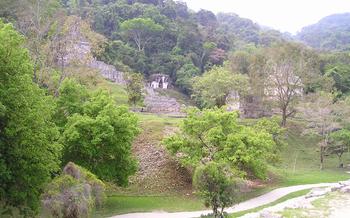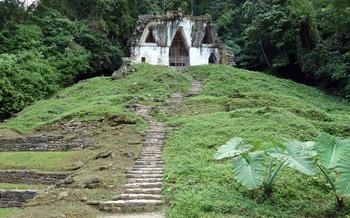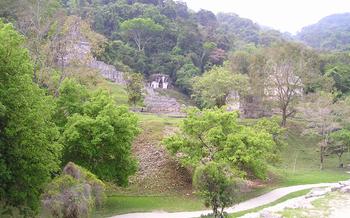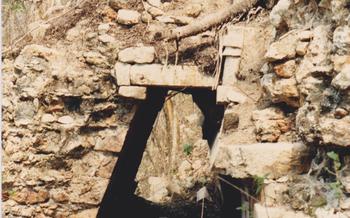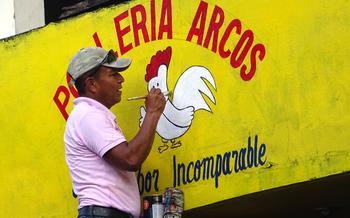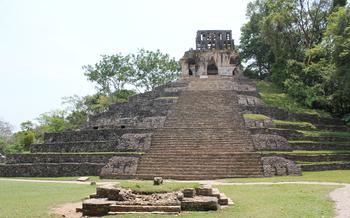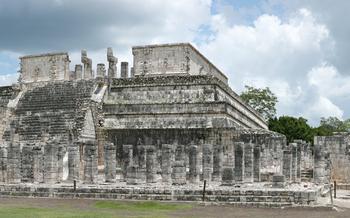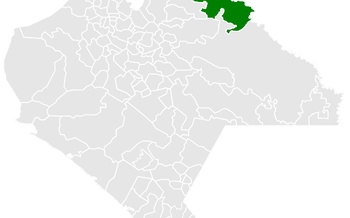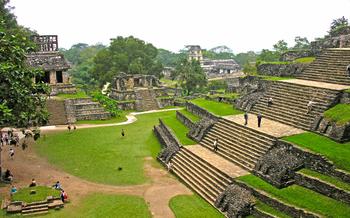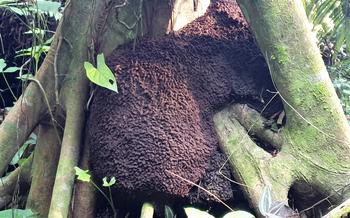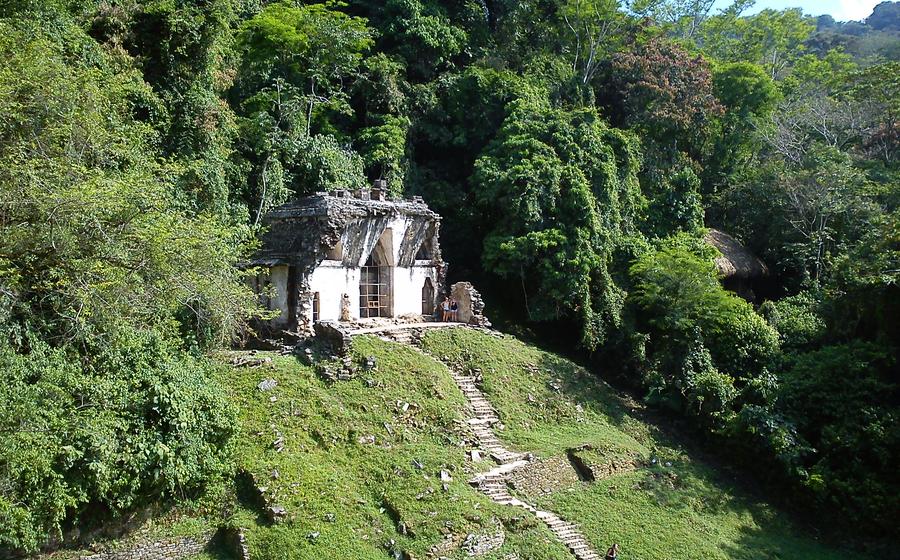
Templo de la Cruz Foliada
- History of the Temple of the Foliated Cross:
- Architectural Features of the Temple of the Foliated Cross
- The Foliated Cross
- The Temple of the Foliated Cross in Popular Culture
- The Temple of the Foliated Cross in Mythology and Legends
- Restoration and Conservation Efforts
- Archaeological Discoveries
- The Temple of the Foliated Cross and Tourism
- The Temple of the Foliated Cross and Environmental Conservation
- The Temple of the Foliated Cross and Sustainable Tourism
- Insider Tip:
History of the Temple of the Foliated Cross:
The Temple of the Foliated Cross, known locally as Templo de la Cruz Foliada, is an ancient Mayan temple located within the ruins of Palenque, Mexico. Its origins date back to the 7th century AD during the reign of King K'inich Janaab' Pakal, one of the most prominent rulers of the Mayan civilization.
The name "Temple of the Foliated Cross" is derived from the intricate carvings on the temple's interior walls, which feature a cross-like symbol with foliated or leaf-shaped elements. This symbol, known as the foliated cross, holds great significance in Mayan culture and is believed to represent the sacred tree of life, symbolizing the connection between the underworld, the earthly realm, and the heavens.
Constructed by the Mayan dynasty that ruled Palenque, the temple served as an important religious center for the Mayan people. It was a place where rituals and ceremonies were performed to honor their gods and communicate with the supernatural realm. The temple's elaborate design and iconography reflect the sophisticated religious beliefs and practices of the ancient Mayans.
Architectural Features of the Temple of the Foliated Cross
The Temple of the Foliated Cross stands out among other Mayan temples for its unique architectural features. Its most striking characteristic is its orientation, which deviates from the cardinal directions. Instead, the temple is aligned with the rising sun during the summer solstice, suggesting a profound understanding of astronomy and celestial events.
The temple's exterior is adorned with intricate carvings and bas-reliefs that depict various scenes from Mayan mythology and history. These carvings provide valuable insights into the beliefs and practices of the ancient Maya. The most notable carving is the foliated cross, which gives the temple its name. The cross is surrounded by four stylized human heads, each representing a different Mayan deity.
The interior of the temple is divided into several chambers, each with its own significance. The main chamber, or sanctuary, is where religious rituals and ceremonies took place. It features a large stone altar, where offerings were made to the gods. The walls of the sanctuary are covered in colorful murals that depict Mayan rulers, priests, and deities engaged in various rituals.
These architectural features, combined with the temple's alignment and intricate carvings, make the Temple of the Foliated Cross a masterpiece of Mayan architecture and a testament to the ingenuity and creativity of the ancient Maya.
The Foliated Cross
The Temple of the Foliated Cross derives its name from the intricate carvings of a foliated cross, a symbol of great significance in Mayan culture, found within the temple. The cross, located on the temple's inner lintel, depicts a stylized tree with four branches, each adorned with three leaves. This symbol represents the sacred ceiba tree, considered the axis mundi, or world tree, in Mayan cosmology. The ceiba tree was believed to connect the underworld, the earthly realm, and the heavens, facilitating communication between the gods and the mortal world.
The foliated cross also holds deep symbolic meaning, representing the four directions, the four winds, and the four seasons. It is associated with the rain god Chaac, who was believed to control the life-giving rains that sustained the Mayan civilization. The cross's central position within the temple highlights its importance in Mayan religious beliefs and rituals, as it was believed to be a portal through which prayers and offerings were transmitted to the gods.
The Temple of the Foliated Cross in Popular Culture
The Temple of the Foliated Cross has captured the imagination of popular culture, appearing in various forms of media such as movies, TV shows, and video games. Its striking visual appearance and rich symbolism have made it a popular subject for filmmakers and storytellers.
One notable portrayal of the temple is in the 1984 film "Indiana Jones and the Temple of Doom." In the movie, the temple is depicted as a hidden sanctuary where a sinister cult practices dark rituals. This portrayal introduced the temple to a global audience, cementing its status as a symbol of ancient mystery and adventure.
In recent years, the temple has also featured in video games such as "Uncharted: Golden Abyss" and "Assassin's Creed IV: Black Flag." These games allow players to explore virtual recreations of the temple, immersing themselves in its intricate architecture and uncovering its hidden secrets.
The portrayal of the Temple of the Foliated Cross in popular culture has significantly contributed to its popularity and recognition among a global audience. These portrayals have sparked interest in Mayan culture and history, encouraging people to learn more about the ancient civilization and its enduring legacy.
While popular culture representations can raise awareness and generate interest, they also pose challenges. It is important to ensure that these portrayals are accurate and respectful, avoiding the perpetuation of stereotypes or misinformation. Balancing entertainment with education is crucial in presenting the temple and Mayan culture in a responsible and authentic manner.
The Temple of the Foliated Cross in Mythology and Legends
The Temple of the Foliated Cross is deeply embedded in Mayan mythology and legends, serving as a sacred site and a backdrop for various stories that have been passed down through generations. According to one legend, the temple was built by a powerful Mayan ruler named Pacal the Great, who ascended to the heavens and became a god after his death. The temple is said to be the portal through which he made his journey, and it is believed that his spirit still resides within its walls.
Another legend tells the story of a beautiful Mayan princess named Ix Mutal, who was chosen as a sacrifice to the gods to ensure a bountiful harvest. Ix Mutal willingly accepted her fate and ascended the steps of the temple, where she was transformed into a dove and flew away, symbolizing her transformation into a divine being. The Temple of the Foliated Cross thus became a symbol of sacrifice and renewal, representing the cyclical nature of life and the belief in an afterlife.
These myths and legends not only provide a glimpse into the spiritual beliefs of the ancient Mayans but also highlight the cultural significance of the temple as a place of reverence, spirituality, and connection with the divine.
Restoration and Conservation Efforts
The Temple of the Foliated Cross has undergone several restoration and conservation efforts throughout its history. The first major restoration project was undertaken in the late 19th century by the Mexican government, which focused on clearing the temple of vegetation and stabilizing its structure. In the 1950s, the Mexican Institute of Anthropology and History (INAH) began a more comprehensive restoration project that involved the excavation of the temple's interior, the reconstruction of its roof, and the conservation of its intricate carvings.
In recent years, INAH has continued to conduct conservation work at the Temple of the Foliated Cross, with a focus on preserving its delicate stucco reliefs and paintings. The institute has also worked to improve the visitor experience by constructing new walkways and providing signage and interpretation panels.
The restoration and conservation efforts at the Temple of the Foliated Cross are essential to ensuring the longevity and integrity of this ancient monument. By preserving the temple's unique architectural features and artwork, these efforts help to protect the legacy of the Maya people and provide a valuable resource for future generations.
Archaeological Discoveries
The Temple of the Foliated Cross has been the site of numerous significant archaeological discoveries, shedding light on the rich history and culture of the ancient Maya. Excavations conducted at the temple have unearthed a wealth of artifacts, including intricately carved stone sculptures, ceramic vessels, jade ornaments, and human remains. These discoveries have provided valuable insights into the daily lives, religious practices, and artistic traditions of the Maya who once inhabited Palenque.
One of the most remarkable discoveries at the Temple of the Foliated Cross was the tomb of an elite Maya ruler, known as Pakal the Great. The tomb was found hidden beneath the temple's floor and contained a wealth of funerary offerings, including a massive carved stone sarcophagus depicting Pakal's journey to the afterlife. The discovery of Pakal's tomb has provided invaluable information about Maya burial practices and the importance of the Temple of the Foliated Cross as a mortuary complex.
Other significant discoveries at the temple include a series of underground tunnels and chambers, which may have been used for ritualistic purposes. Archaeologists have also found evidence of extensive modifications and renovations to the temple over time, suggesting that it was a continuously evolving and important structure throughout the history of Palenque.
The ongoing archaeological research at the Temple of the Foliated Cross continues to yield new insights into the fascinating world of the ancient Maya. These discoveries help us to piece together the history of this remarkable civilization and gain a deeper appreciation for their cultural achievements.
The Temple of the Foliated Cross and Tourism
The Temple of the Foliated Cross, with its striking architecture and historical significance, has become a popular tourist destination in Palenque. While tourism brings economic benefits to the region, it also poses challenges in terms of preserving the temple and managing the impact on the surrounding environment. Responsible tourism practices are crucial to ensure the long-term sustainability of the site.
Visitors should prioritize guided tours led by knowledgeable local guides who can provide insights into the temple's history and cultural significance. This not only enhances the visitor experience but also supports the local economy. Respecting the temple's sacredness and avoiding touching or climbing on the structures is essential to preserving its integrity.
Choosing accommodations and restaurants that prioritize sustainability, such as those that use local ingredients and employ environmentally friendly practices, contributes to the overall well-being of the region. Visitors are encouraged to minimize their environmental footprint by reducing single-use plastics, conserving water and energy, and disposing of waste responsibly.
By embracing responsible tourism, visitors can contribute to the preservation of the Temple of the Foliated Cross and support the local community while having a meaningful and enriching experience.
The Temple of the Foliated Cross and Environmental Conservation
The Temple of the Foliated Cross stands as a testament to the deep connection between the Mayan people and their natural environment. Situated amidst the lush rainforests of Chiapas, the temple's preservation is inextricably linked to the conservation of the surrounding ecosystem. However, the temple and its environs face various environmental threats, including deforestation, pollution, and climate change.
Deforestation poses a significant threat to the temple's integrity. The clearing of forests for agriculture, development, and other purposes leads to habitat loss for wildlife, soil erosion, and changes in local climate patterns. These factors can impact the stability of the temple's structures and the surrounding ecosystem.
Pollution from various sources, including agricultural runoff, industrial emissions, and tourism activities, also poses a threat to the temple. Chemicals and pollutants can damage the temple's delicate carvings and artwork, contributing to their deterioration over time.
Climate change is another pressing environmental concern that affects the Temple of the Foliated Cross. Rising temperatures, changes in precipitation patterns, and more frequent extreme weather events can lead to structural damage to the temple, as well as impact the surrounding flora and fauna.
To address these challenges, local communities and conservation organizations are working together to protect the temple and its surroundings. Reforestation efforts, sustainable agriculture practices, and waste management initiatives are being implemented to mitigate the impacts of deforestation and pollution. Conservationists are also working to raise awareness about the importance of preserving the temple's natural environment and encouraging visitors to adopt responsible tourism practices.
As visitors to the Temple of the Foliated Cross, we have a responsibility to minimize our environmental impact and support conservation efforts. By choosing tour operators that prioritize sustainability, reducing our waste, and respecting the local environment, we can contribute to the preservation of this ancient treasure for generations to come.
The Temple of the Foliated Cross and Sustainable Tourism
The Temple of the Foliated Cross, like many other ancient sites, faces the challenges of balancing tourism development with the preservation of its cultural and natural heritage. Sustainable tourism practices are crucial to ensuring that the temple and its surroundings remain intact for future generations while also benefiting local communities.
As a visitor, you can contribute to sustainable tourism by choosing tour operators and hotels committed to responsible practices. Look for tour operators that use eco-friendly transportation, support local guides, and promote cultural sensitivity. Opt for hotels that prioritize energy efficiency, water conservation, and waste reduction.
When visiting the temple, respect the local environment by avoiding littering, staying on designated trails, and refraining from touching or damaging the ancient structures. Support local businesses by purchasing souvenirs from local artisans and dining at restaurants that source ingredients from local farmers.
By embracing sustainable tourism practices, you can help preserve the Temple of the Foliated Cross and its surroundings while supporting the local economy and fostering cultural exchange. Together, we can ensure that this ancient treasure remains a source of wonder and inspiration for generations to come.
Insider Tip:
Venturing off the beaten path at the Temple of the Foliated Cross can lead to hidden gems that offer a glimpse into the temple's rich history and spiritual significance. One such spot is the nearby Temple of the Sun, which is less visited but equally impressive. Its intricate carvings and well-preserved condition make it a worthwhile addition to your exploration of Palenque's ancient wonders.
For a unique perspective, consider visiting the temple during the early morning hours when the site is bathed in a soft, golden light. The tranquility of the surroundings and the absence of crowds create an ideal atmosphere for contemplation and reflection, allowing you to connect with the temple's spiritual energy on a deeper level.
To enhance your experience further, engage with local tour guides who can share insights into the temple's history, symbolism, and cultural significance. Their knowledge and passion will bring the ancient Mayan world to life, providing a richer understanding of this awe-inspiring site.
As you explore the Temple of the Foliated Cross, remember to be a responsible traveler. Respect the sanctity of the site, minimize your environmental impact, and support local communities by purchasing souvenirs and handicrafts from vendors who are committed to sustainable practices. Together, we can contribute to the preservation and protection of this remarkable cultural treasure for generations to come.
